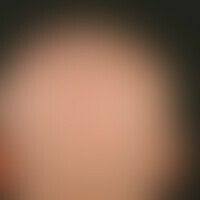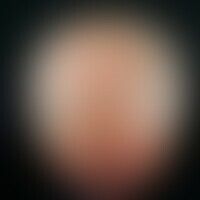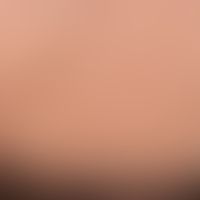Image diagnoses for "skin-colored", "Scalp (hairy)"
28 results with 68 images
Results forskin-coloredScalp (hairy)

Alopecia areata (overview) L63.8
Alopecia areata totalis: complete hair loss except for a few individual hairs; with greater enlargement, the preserved (hairless) follicles can be seen

Atheroma L72.10

Alopecia androgenetica in men L64.-
Alopecia androgenetica in men, stage III/IV: Confluence of anterior and posterior hair thinning in the parietal region.

Aplasia cutis congenita (overview) Q84.81

Atrichia congenita with horny cysts Q84.0

Atheroma L72.10

Alopecia androgenetica in men L64.-
Alopecia androgenetica in men; stage IV: horseshoe-shaped, complete clearing of the hair in the parietal region; remaining lateral and posterior crown of hair

Alopecia areata (overview) L63.8
Alopecia areata: Typical clinical finding of an alopecia areata with concomitant circumscribed scleroderma.

Alopecia areata (overview) L63.8
Alopecia areata: Still relapsing-active alopecia areata: Marginal area, cadaverized hair and exclamation mark-like hair, as a sign of the still existing progression of the process.

Early syphilis A51.-

Alopecia areata (overview) L63.8
Alopecia areata. roundish, centrifugally and medially spreading, smooth, hairless areas with preserved follicles. in the active marginal area hair can be pulled out in tufts. under internal steroid treatment with methylprednisolone for 4 weeks the hair loss stopped and re-growth in places occurred.

Nevus sebaceus Q82.5
Sebaceous nevus: clinical aspect of a sebaceous nevus in a few-month-old infant; only the slight plaque-like elevation of the hairless area indicates the actual diagnosis.

Aplasia cutis congenita (overview) Q84.81

Frontal fibrosing alopecia L66.8
Alopecia postmenopausal, frontal, fibrosing: uniform receding of the frontal and temporal hairline. moderately pronounced ulerythema ophryogenes. keratosis follicularis on the extensor extremities.

Frontal fibrosing alopecia L66.8
Alopecia, post-menopausal, frontal, fibrosing: typical follicular inflammatory pattern (see frontal hairline). No symptoms. This results in a backward development of the forehead-hairline.









